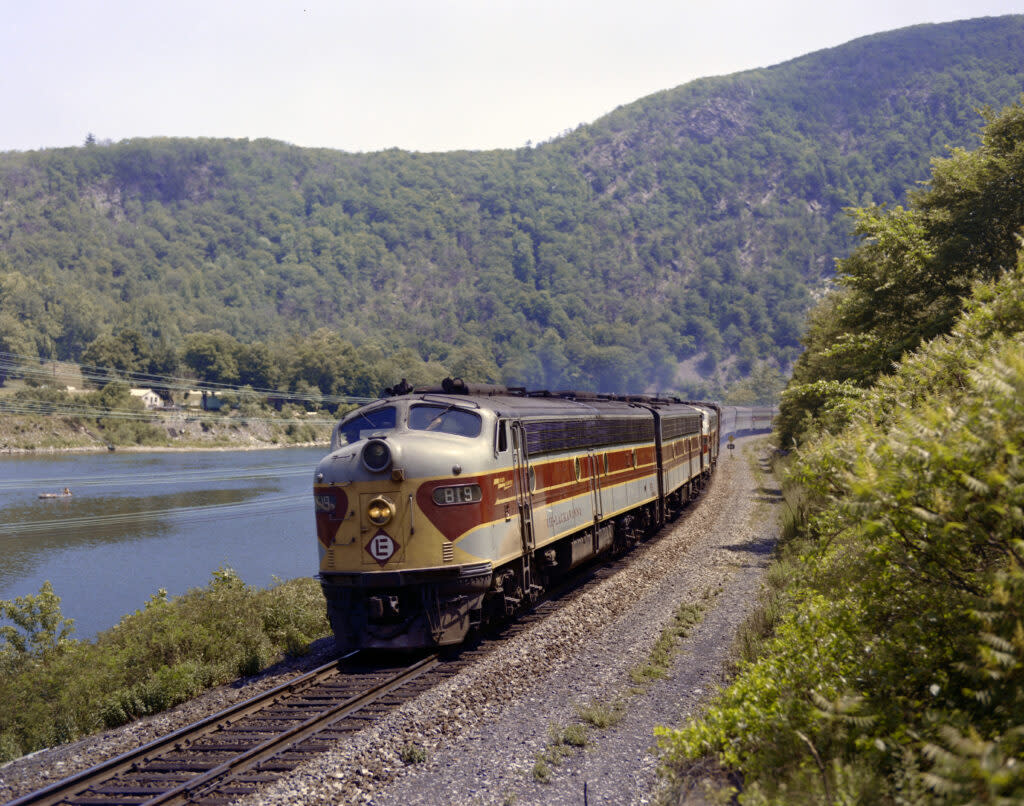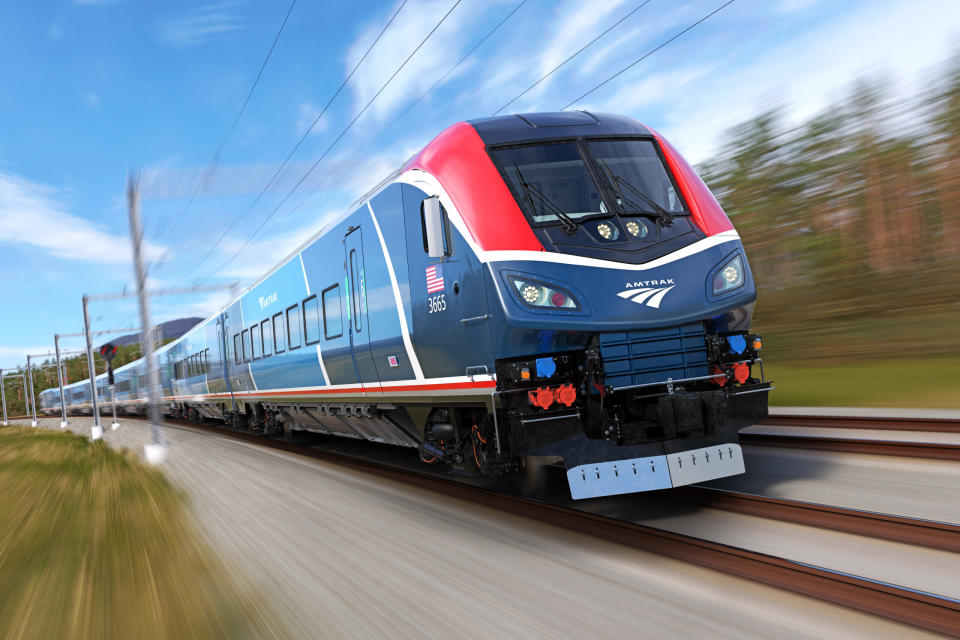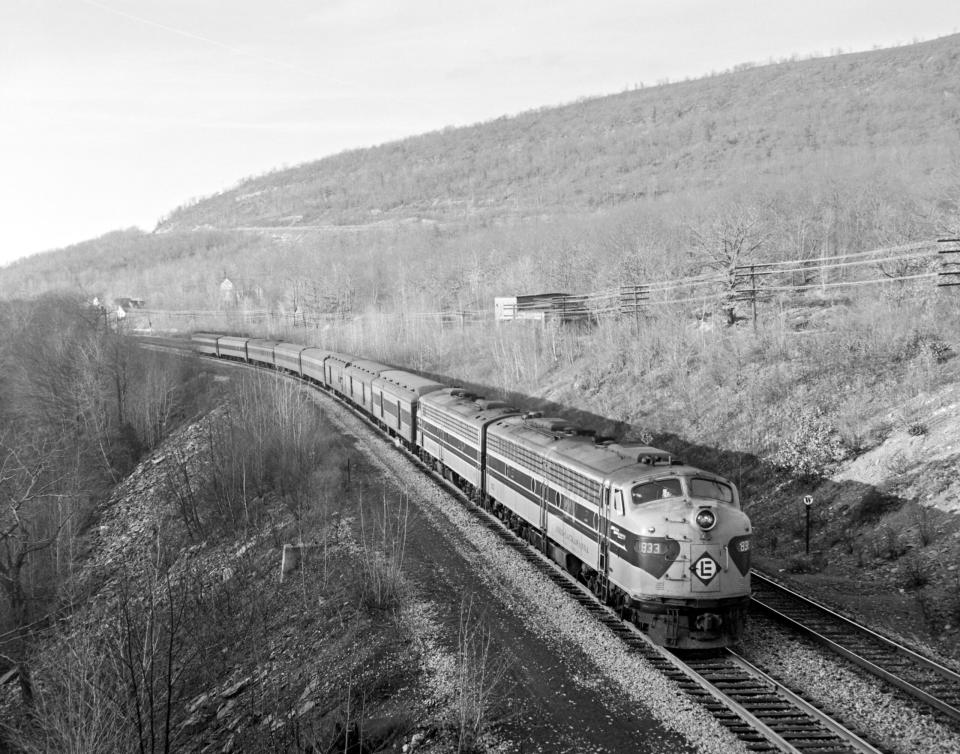Back on Track: Scranton may finally see the return of a passenger rail line to NYC

- Oops!Something went wrong.Please try again later.
- Oops!Something went wrong.Please try again later.
The Erie Lackawanna Railroad's "Phoebe Snow" passenger train passes the Delaware Water Gap on June 20, 1965. The Bipartisan Infrastructure Law could return passenger service to the line between Scranton and New York after decades of effort. (Photo by Victor Hand, used by permission of the Center for Railroad Photography & Art)
It’s been more than 50 years since passenger trains ferried travelers from Scranton to New York City, and many in Northeast Pennsylvania had given up hope that a rail line would ever return. But funding from the 2021 bipartisan infrastructure law may finally bring back passenger trains to run between the Electric City and the Big Apple.
“We’re at the point where it’s ours to lose,” U.S. Rep. Matt Cartwright (D-8th District), told the Capital-Star.
As U.S. Sen. Bob Casey (D-Pa.) — one of the rail line’s biggest boosters— campaigns in Scranton today, the chances that the region will see a return of its rail line seem brighter than ever.
When the U.S. Senate voted to pass the $1.2 trillion package in August 2021, Casey voted in favor, while then-U.S. Sen. Pat Toomey (R-Pa.) voted against it. In the lower chamber, every Democrat in Pennsylvania’s U.S. House delegation, plus Rep. Brian Fitzpatrick (R-1st District), voted in favor of the bill.
As Casey seeks a fourth term in office, he’s often touted the passage of the infrastructure bill and the impact he believes it will have across the Keystone State during his campaign.
Given the Casey family’s longtime presence in Scranton, it’s perhaps not surprising that Sen. Casey has been a supporter of reestablishing the rail line for several years. Back in 2008, Casey sent a letter with then-Sens. Arlen Specter (R-Pa.), and Democrats Hillary Clinton and Chuck Schumer of New York describing why the rail line would be crucial for the region.
“There is strong interest among local residents in Binghamton and Scranton who would take advantage of this new service between the cities and also use it to ultimately gain access to New York City,” the lawmakers wrote in the 2008 letter. “Additionally, with this new service, more business and leisure travelers from New York City would be able to access the many assets that Binghamton and Scranton have to offer and tap into the local economy for new economic development opportunities.”
Casey has spent the years since continuing to urge other lawmakers to support the project.
He sounded cautiously optimistic during a brief conversation June 17 with the Capital-Star, but noted that the project wasn’t yet in the final stages of getting the funding
“We’re going to keep pushing it. We know the initial commitment has been made, but we still have a lot of work to do to make sure that funding is targeted for that project,” Casey said. “I want to see a commitment made in the next year.”
But if Casey’s Republican challenger David McCormick wins the election in November, the future of the Scranton rail line isn’t guaranteed. McCormick said earlier this year he’d vote to repeal the bipartisan infrastructure law funding the project.
On Feb. 13, McCormick participated in a roundtable discussion on trade practices in Northeast Pennsylvania. During the discussion, GOP Lackawanna County Commissioner Chris Chermak mentioned the potential impact of the train.
“This is a big push with Senator Casey, is the train coming to town from New York City,” Chermak said, adding he thought it would be a boost to the economy “somewhat,” but was concerned the train would bring New York City “issues” to the area.
“It’s going to change life as we know it here,” Chermak added.
McCormick didn’t directly endorse or oppose the proposed rail line, saying he didn’t “know the facts, the pros and cons.”
“And by the way, the fact that many jobs now have become more remote is incredibly advantageous to a place like Pennsylvania and this particular area, which is wonderful and beautiful and people want to live here,” McCormick added.
McCormick told the Capital-Star in a June 14 email that while he wants to invest in infrastructure, he doesn’t agree with the way the Biden administration has gone about it.
“I’m a strong supporter of investing in hard infrastructure to update our transportation networks and expand broadband access,” McCormick said in a statement to the Capital-Star. “Biden and Casey held these investments hostage — wrapping them up with pork to further their extreme climate agenda. This project could be accomplished without billions for EV charging stations and a Green New Deal slush fund.”
Elected Democrats in the region said they have heard concerns from some constituents about the train, but ultimately the overall reaction has been positive.
“Sure, change is scary,” Cartwright said. “But I submit that this is a change that is not very scary at all for northeastern Pennsylvania.”
The rail line had already existed for 100 years between metropolitan New York City and Scranton, he noted.
GET THE MORNING HEADLINES DELIVERED TO YOUR INBOX
State Rep. Kyle Mullins (D-Lackawanna), who also serves on the Pennsylvania House Transportation Committee, said he didn’t share Chermak’s concerns about the train bringing New York issues to Scranton.
“There is nothing right now really stopping a good or bad influence because of that proximity,” Mullins told the Capital-Star. “A train… will not be some new problematic artery for our region.”
State Sen. Marty Flynn, Minority Chair of the Pennsylvania Senate Transportation Committee and lifelong resident of Northeast Pennsylvania, described the concern from Chermak as “very close minded,” echoing a similar point from Mullins.
The Democrats also said the rail line would help alleviate traffic congestion on I-80, encourage more travel, and draw remote workers to relocate to the region.
With comparatively low costs of living, northeast Pennsylvania has become an attractive place to live for workers in New York and north Jersey. That has contributed to some of the longest commuting times in Pennsylvania. According to the U.S. Census Bureau, the average commute is about 39 minutes in Monroe County and nearly 44 minutes in neighboring Pike County.
If the current proposal becomes reality, passengers could travel between the two cities in less than three hours at speeds of up to 110 mph.
A ‘Super-railroad’
The rail corridor from Hoboken, N.J., to Scranton was constructed as part of the Delaware, Lackawanna & Western Railroad’s (DL&W) 400-mile main line that continued to Buffalo, N.Y.
The stretch across rural northwest New Jersey, known as the Lackawanna Cut Off, was billed as a “super-railroad” when it opened, according to a history of the line by rail advocate Walsh. Completed in 1911, the rail line carried passengers and freight until the 1970s.
Using cutting-edge construction techniques to level hills and valleys and straighten curves, trains were able to run at more than 80 mph, an impressive speed for the time. It also boasted a valley-spanning viaduct that was the largest reinforced concrete structure in the world.
The line last carried passengers in 1970, and after the final freight rolled through in 1979, efforts to preserve it began immediately. But restoring service on the line faced decades of economic and political hurdles.
In the 1980s, Conrail, the government-owned railroad that acquired the DL&W’s bankrupt successor, stymied efforts by the Monroe County Rail Authority to purchase the Pennsylvania section of the rail line. On the New Jersey side of the river, Conrail scrapped the tracks and sold the right-of-way to developers.
It took until 2001 for Pennsylvania and New Jersey authorities to acquire their respective sections of the railroad. That year, New Jersey Transit paid $21 million for the 28-mile right-of-way in New Jersey. The predecessors of Pennsylvania Northeast Regional Railroad Authority (PNRRA) had earlier purchased the 60 miles of track between Scranton and Delaware Water Gap for about $10 million.
But even with the railroad in the hands of government agencies that supported the passenger rail restoration project, progress would be slow.
“The challenge has always been to obtain the funding necessary to do this,” said Chuck Walsh, president of the North Jersey Rail Commuter Association, who has been an advocate of restoring passenger service on the line since the 1980s.
It was Specter who secured the first federal funding for the project in 2003, with $2 million to conduct the preliminary engineering. And although the project also drew political support from Casey and Schumer, the next major advance came in 2008, when New Jersey approved $61 million in federal and state funding to extend existing commuter rail service seven miles closer to Scranton on the Lackawanna Cut Off.
Work on that section, including the rehabilitation of a tunnel and construction of a new station is underway and New Jersey Transit service on the restored section is expected to begin in 2026.
That development has helped to overcome the psychological hurdle of believing the restoration of passenger service is possible, Walsh said.
“You have to get used to the idea that you can reactivate an abandoned line,” Walsh said. “That is something that virtually never happens.”
PNRRA President Larry Malski pressed that point as he spoke to members of the Pennsylvania House Democratic Policy Committee last year and requested continued funding from the state Legislature. The federal government, New Jersey and Pennsylvania have already spent more than $94.5 million on acquisition and construction.
“This is not only a ‘shovel ready’ infrastructure project, but actually a ‘shovel in the ground’ infrastructure project that will pay back major economic development, transportation alternative and tourism and recreation benefits to northeastern Pennsylvania and the commonwealth for many generations to come,” Malski said in his prepared testimony.
Potential economic impact
A March 2023 study conducted by Amtrak projected rail service between Scranton and New York could generate $84 million in economic activity, while serving just under 475,000 riders annually.
Cartwright told the Capital-Star that the project has been his top priority since he was elected to Congress in 2012. Shortly after being sworn in, Cartwright said he had conversations with PNRRA officials Malski, Dominic Keating, and Bob Hay.
Like Casey, he also spent the following years whipping up support for the project among his colleagues, including in May 2021 when he founded the Lackawanna Cutoff Rail Restoration Caucus with inaugural members U.S. Reps. Susan Wild (D-7th District), Josh Gottheimer (D-NJ), and Mikie Sherrill (D-NJ).
Cartwright also credited Gov. Josh Shapiro’s commitment to the project. He said Shapiro agreed to provide $125 million in local-match funds, have PennDOT author the application to the Federal Railroad Administration, and co-sponsor it along with New Jersey Transit.
In December 2023, the project took another step forward with the Federal Railroad Administration (FDA) including Northeastern Pennsylvania in its Corridor Identification and Development (Corridor ID) Program.
“We are supremely confident that this line will get the go ahead and that sometime probably by mid to late 2028, you will see Amtrak trains turning around in Scranton,” Cartwright told the Capital-Star. “There’ll be three round trips a day to begin with and I expect that to expand because they’re going to find out very, very rapidly that these trains will sell out.”
Rob Bresnahan, Republican candidate for the 8th Congressional District, holds a different point of view about the bipartisan infrastructure funding for the potential rail service.
“Nearly one-quarter of all bridges in Congressman Cartwright’s district are rated as structurally deficient,” Bresnahan wrote in an email to the Capital-Star, citing a report from the American Road and Transportation Builders Association (ARTBA). “We should address the existing infrastructure problems in our district well before any conversations about creating once-a-day train routes to midtown Manhattan.”
Malski, of the PNRRA, left a corporate position with an upstate New York railroad in the mid-1980s to work for local government in northeast Pennsylvania as a consultant on preserving rail lines. In what he called dark times for railroads, he and political leaders weathered a lot of criticism for spending tax money on abandoned lines.
“If you don’t save them before they are completely ripped up and sold you’ll never have those as corridors for commerce,” Malski said. The existence of freight rail service in Monroe and Lackawanna counties has resulted in 20 new manufacturing sites in the region, including a flour mill that receives shipments of grain by rail from North and South Dakota, Malski said.
“It’s the kind of industry that we desperately need in Pennsylvania because we lost so much,” Malski said.
Passenger service would add to the region’s prosperity by connecting it with one of the world’s financial capitals and by providing access for tourists to the Poconos’ attractions, Malski added.
“When the bipartisan infrastructure bill passed … we tried to jump in as quickly as we could,” Malski said, noting that Amtrak has endorsed Scranton to New York as a top choice for new service because the route is 100% publicly owned.
And despite McCormick’s threats to repeal the Infrastructure and Jobs Act, Cartwright said he isn’t concerned about the law being overturned noting a filibuster proof majority would be needed for it to happen.
Currently, 51 Senators caucus with the Democratic Party, while 49 Senators caucus with the Republican Party. For the law to be overturned, two-thirds of the U.S. Senate would have to agree. In 2021, 69 Senators voted in favor of the law.
“Remember, this was a law that attracted good support from both sides of the aisle to begin with,” Cartwright said. “So to think that kind of spitefulness could take root in the next Congress and the next administration, I think that’s that’s fanciful.”
And fears about what the rail line might bring to the area are mostly unfounded, he added.
“This is not scary,” Cartwright said. “This is Northeastern Pennsylvania coming back.”
The post Back on Track: Scranton may finally see the return of a passenger rail line to NYC appeared first on Pennsylvania Capital-Star.




